Sutton, Dublin
| Sutton Irish: Cill Fhionntáin | |
|---|---|
| Suburb | |
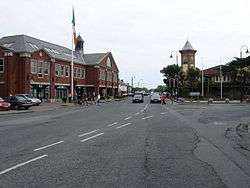 Sutton Cross | |
 Sutton Location in Ireland | |
| Coordinates: 53°23′10″N 6°06′00″W / 53.38611°N 6.10000°WCoordinates: 53°23′10″N 6°06′00″W / 53.38611°N 6.10000°W | |
| Country |
|
| Province | Leinster |
| County | Dublin |
| Administrative County | Fingal |
| Population (2016) | |
| • Total | 5,680 |
Sutton (Irish: Cill Fhionntáin – Fintan's cell or church)[1] is a residential suburb on the Northside of Dublin, Ireland. It occupies the tombolo which links Howth Head to the mainland, some of the lower slopes of Howth Hill, and a little of the adjacent coasts. The area lies within the jurisdiction of Fingal County Council. There is a small commercial core at the Sutton Cross road intersection.
Sutton lies in the ancient Barony of Coolock, within the historic County Dublin.
Location and geography
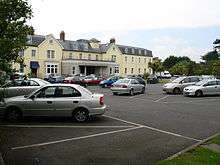
Location
Historically Sutton lay entirely on the Howth peninsula, from Sutton Cross up to Claremont road and the Martello Tower at Red Rock. Today however, it is generally considered to extend to the railway, where it meets Baldoyle, and to the junction of Baldoyle Road and the coast road, where it meets Bayside, these additional lands historically having been farmland.
Access
Beginning on the Howth Road (R105) about 12 kilometres from the city centre, Sutton neighbours Howth, which occupies most of the Howth peninsula, and Baldoyle and Bayside. It is served by the main road from Dublin to Howth (R105). Dublin Bus serves the area with route 31 and its variants from the city centre, as well as route 102 which connects Sutton railway station to Dublin Airport. There is a cycleway that connects Sutton to Clontarf and Fairview, with works ongoing to connect to Sandymount.[2]
Sutton railway station[3] opened on 30 July 1846[4] as Baldoyle & Sutton, being renamed Sutton in 1901. The station is served by the DART.
The Hill of Howth Tramway ran between Sutton railway station and Howth railway station around the Hill of Howth until 1959.

Geography
At the core of Sutton is a tombolo connecting Howth (which used to be an island) to the mainland. The original village of Sutton was situated on the city-facing (south-western) side of Howth Head, along Strand Road, where there are today housing terraces and a small harbour, but the area is now centred on Sutton Cross.
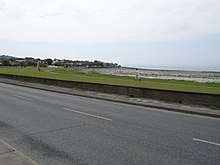
Streams
There are several small streams in the area, all substantially culverted. Some tiny flows cross the Sutton end of the Cliff Walk paths, and two bigger streams, Santa Sabina Stream and the Carrickbrack Stream, discharge at the coast on Sutton Strand[5]:8 in front of Saint Fintan's Roman Catholic church. sometimes very actively, sometimes largely covered by sand, which is then cleared by Fingal County Council staff.
Carrickbrack Stream rises between Shielmartin Hill and Dun Hill near Howth Golf Course, and flows, meeting minor tributaries, roughly parallel to Carrickbrack Road, coming to the shore at the south-western end of Sutton Strand.[5]:8 Santa Sabina Stream comes from the central area of the Howth (Deer Park) Estate, and runs in culvert past the Offington housing estate and through the grounds of Santa Sabina Dominican Convent, reaching the sand around 150m north of the mouth of the Carrickbrack.[5]:8 The mouth of the Santa Sabina has concrete framing and a guard rail.
Beaches
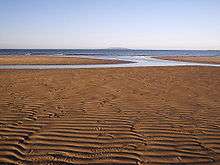
Sutton is surrounded by many beaches. The Burrow Beach is particularly popular among locals and tourists. It is approximately 1.2 km and stretches from Sutton Golf Club to Howth, along one side of the tombolo connecting Howth Head to the mainland.[6] Sutton Strand runs along the coast road and in front of St. Fintan's church.
Amenities
There is one main commercial area, with a Supervalu (previously Superquinn) supermarket under the chain's HQ, which in turn had replaced the local cinema), the Marine Hotel, a post office, and other banking, dining and retail operations. The local filling stations closed some years back, leaving the unattended Maxol filling station in coastal Kilbarrack and its attended station on the Baldoyle Road as the only fuelling facilities nearby.
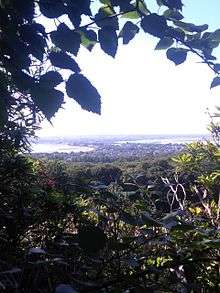
Sports and leisure activities
There is dinghy sailing off the coast at Sutton Dinghy Club, which is Ireland's largest dinghy club and is based within Sutton Creek. Golf can be played at Sutton Golf Club, with Howth and the Deerpark golf facilities nearby; footgolf and poc fada can also be played at Deerpark. Suttonians Rugby Football Club, at Station Road, provides for local rugby players and supporters. Sutton Tennis Club has 12 outdoor courts and three indoor squash courts; it is the biggest club for junior squash in the Republic of Ireland.[7] The local soccer club is Howth Celtic whose grounds are located opposite St.Fintan's primary school on Carrickbrack Road. There is a local scout group which meets in St. Mary's Church of Ireland Parish Hall in Howth.
Red Rock is a trailhead for the Cliff Walk which navigates a large section of Howth Head and ends at Howth village. Shielmartin Hill is also readily accessible from Sutton.
Buildings
The area is home to one of Ireland's Martello Towers (now a private residence), can be found at Red Rock. Also located in Red Rock is Sutton Castle, the former home of the Jameson family, and later became the residence of Belgian businessman Albert Luykx, made famous during the Irish arms trial. It subsequently became Sutton House Hotel and then Sutton Castle Hotel, before being converted in 2003 to private residences. [8][9]
The old tram shed which was used by the Hill of Howth Tramway is located near Sutton Station, but is now a private residence which is part of a modern housing development.[10]
Education
Sutton has three mixed primary schools: the Burrow School, on the Dublin Road between Sutton Cross and Howth, St. Fintan's National School, on Carrickbrack Road, and the primary part of Sutton Park School. It holds three secondary schools: St. Fintan's High School (a boys school, technically in Baldoyle), Santa Sabina Dominican College[11] (a.k.a. Santa Sabina) (girls) and the senior part of Sutton Park School (mixed).
Religion
Sutton comprises a parish in the Roman Catholic church, St.Fintans, within the deanery of Howth, with a parish church[12][13] at the base of Howth Hill, adjacent to Santa Sabina School, at the junction of Greenfield Road and Church Road.
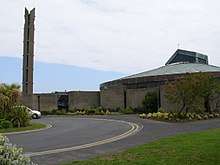
There is also a Methodist church[14] at the junction of Church Road and Howth Road.

Sutton contains one of Dublin's main burial grounds, St. Fintan's, which is divided into two parts, "old" and "new." The former contains a ruined chapel, and the latter, an abandoned keeper's cottage.
Uphill from the older graveyard, in a wooden hut on private grounds, is the still-flowing holy well of St. Fintan.[15]
Administration
Sutton is part of the Dublin Bay North Dáil Éireann constituency, having previously been part of Dublin North-East for many years.
The area is also within the Howth-Malahide local electoral area of Fingal County Council. Sutton also forms an electoral division.
Notable residents
- Ian Dempsey, radio and television presenter
- Jim Fitzpatrick, artist, Celtic style work but also created the iconic two-tone portrait of Che Guevara, Burrow Road
- Gerry Gannon, one of Ireland's biggest property developers, part owner of the K Club and MD of Gannon Homes, formerly building, for example, Clongriffin housing estate, and with extensive land holdings in the area
- Patrick Hillery, former President of Ireland; lived in Sutton for many years until his death in 2008
- Vogue Williams was educated in Santa Sabina.[16]
- Frank Kearns, owner of Rockschool and founder of Irish Rock group Cactus World News
- Philomena Lynott, mother of Phil Lynott, who lived here briefly in the 1980s, and is buried here.
- Larry Mullen, Jr., drummer with rock group U2
See also
References
- ↑ Logainm- Placename database of Ireland. "Cill Fhionntáin". Retrieved 5 January 2018.
- ↑ http://www.dublinlive.ie/news/dublin-news/latest-phase-sutton-sandycove-cycleway-12989925
- ↑ Archiseek web page on Sutton Railway station Archived 6 October 2008 at Archive.is
- ↑ "Baldoyle and Sutton station" (PDF). Railscot – Irish Railways. Retrieved 3 September 2007.
- 1 2 3 Doyle, Joseph W. (2013) [2008]. Ten Dozen Waters: The Rivers and Streams of County Dublin (7th edition). Dublin, Ireland: Rath Eanna Research. pp. i–iv, 1–76 + photos and map. ISBN 978-0-9566363-6-2.
- ↑ Council, Fingal County. "The Burrow beach : : Fingal County Council". fingalcoco.ie. Retrieved 1 December 2016.
- ↑ http://www.suttonltc.com
- ↑ http://archiseek.com/2010/1880-sutton-castle-hotel-sutton-co-dublin/
- ↑ https://www.businesspost.ie/legacy/luxury-living-at-sutton-castle-apartments-55432
- ↑ http://www.nationaltransportmuseum.org/b004.html
- ↑ Santa Sabina Dominican College
- ↑ Archiseek page on St. Fintans' Roman Catholic Church
- ↑ Photo of St. Fintans' Church
- ↑ Photo of Sutton Methodist Church
- ↑ http://irelandsholywells.blogspot.ie/2012/05/saint-fintans-well-sutton-county-dublin.html?m=1
- ↑ https://amp.independent.ie/lifestyle/vogue-mcfadden-brian-is-all-i-could-have-wished-for-29836492.html
External links
| Wikimedia Commons has media related to Sutton, Dublin. |